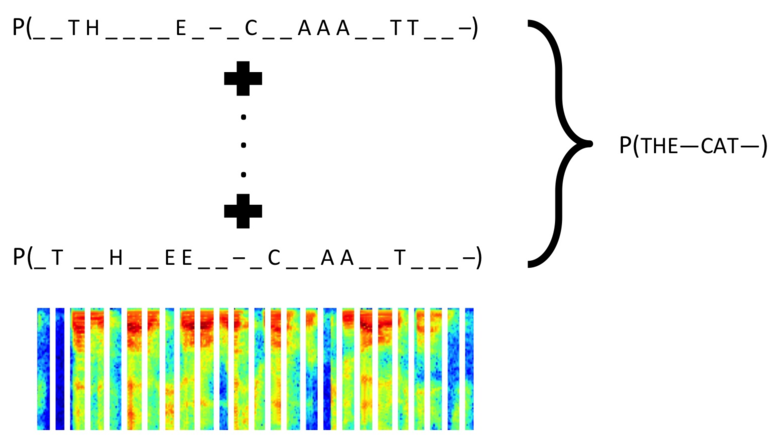A fast parallel implementation of CTC, on both CPU and GPU.
Connectionist Temporal Classification is a loss function useful for performing supervised learning on sequence data, without needing an alignment between input data and labels. For example, CTC can be used to train end-to-end systems for speech recognition, which is how we have been using it at Baidu's Silicon Valley AI Lab.
The illustration above shows CTC computing the probability of an output sequence "THE CAT ", as a sum over all possible alignments of input sequences that could map to "THE CAT ", taking into account that labels may be duplicated because they may stretch over several time steps of the input data (represented by the spectrogram at the bottom of the image). Computing the sum of all such probabilities explicitly would be prohibitively costly due to the combinatorics involved, but CTC uses dynamic programming to dramatically reduce the complexity of the computation. Because CTC is a differentiable function, it can be used during standard SGD training of deep neural networks.
In our lab, we focus on scaling up recurrent neural networks, and CTC loss is an important component. To make our system efficient, we parallelized the CTC algorithm, as described in this paper. This project contains our high performance CPU and CUDA versions of the CTC loss, along with bindings for Torch. The library provides a simple C interface, so that it is easy to integrate into deep learning frameworks.
This implementation has improved training scalability beyond the performance improvement from a faster parallel CTC implementation. For GPU-focused training pipelines, the ability to keep all data local to GPU memory allows us to spend interconnect bandwidth on increased data parallelism.
Our CTC implementation is efficient, compared with many of the other implementations publically available. All calculations are performed in log-space for numerical stability, we have found cases where this was required while training our Deep Speech models. We compare our performance with Eesen, as well as with a CTC implementation built on Theano. We benchmark the Theano implementation operating on 32-bit floating-point numbers and doing the calculation in log-space, in order to match the other implementations we compare against.
We show results on two problem sizes relevant to our English and Mandarin end-to-end models, respectively, where T represents the number of timesteps in the input to CTC, L represents the length of the labels for each example, and A represents the alphabet size.
On the GPU, our performance at a minibatch of 64 examples ranges from 7x faster to 155x faster than Eesen, and 46x to 68x faster than the Theano implementation.
Benchmarked on a single NVIDIA Titan X GPU.
| T=150, L=40, A=28 | warp-ctc | Eesen | Theano |
|---|---|---|---|
| N=1 | 3.1 ms | .5 ms | 67 ms |
| N=16 | 3.2 ms | 6 ms | 94 ms |
| N=32 | 3.2 ms | 12 ms | 119 ms |
| N=64 | 3.3 ms | 24 ms | 153 ms |
| N=128 | 3.5 ms | 49 ms | 231 ms |
| T=150, L=20, A=5000 | warp-ctc | Eesen | Theano |
|---|---|---|---|
| N=1 | 7 ms | 40 ms | 120 ms |
| N=16 | 9 ms | 619 ms | 385 ms |
| N=32 | 11 ms | 1238 ms | 665 ms |
| N=64 | 16 ms | 2475 ms | 1100 ms |
| N=128 | 23 ms | 4950 ms | 2100 ms |
Benchmarked on a dual-socket machine with two Intel E5-2660 v3 processors - warp-ctc used 40 threads to maximally take advantage of the CPU resources. Eesen doesn't provide a CPU implementation. We noticed that the Theano implementation was not parallelizing computation across multiple threads.
| T=150, L=40, A=28 | warp-ctc | Eesen | Theano |
|---|---|---|---|
| N=1 | 2.6 ms | -- | 15 ms |
| N=16 | 3.4 ms | -- | 180 ms |
| N=32 | 3.9 ms | -- | 375 ms |
| N=64 | 6.6 ms | -- | 700 ms |
| N=128 | 12.2 ms | -- | 1340 ms |
| T=150, L=20, A=5000 | warp-ctc | Eesen | Theano |
|---|---|---|---|
| N=1 | 21 ms | -- | 850 ms |
| N=16 | 37 ms | -- | 10800 ms |
| N=32 | 54 ms | -- | 22000 ms |
| N=64 | 101 ms | -- | 42000 ms |
| N=128 | 184 ms | -- | 86000 ms |
The interface is in
include/ctc.h.
It supports CPU or GPU execution, and you can specify OpenMP parallelism
if running on the CPU, or the CUDA stream if running on the GPU. We
took care to ensure that the library does not perform memory
allocation internally, in order to avoid synchronizations and
overheads caused by memory allocation.
warp-ctc has been tested on Ubuntu 14.04 and OSX 10.10. Windows is not supported at this time.
First get the code:
git clone
cd warp-ctc
create a build directory:
mkdir build
cd build
if you have a non standard CUDA install export CUDA_BIN_PATH=/path_to_cuda so that CMake detects CUDA and
to ensure Torch is detected, make sure th is in $PATH
run cmake and build:
cmake ../
make
The C library and torch shared libraries should now be built along with test
executables. If CUDA was detected, then test_gpu will be built; test_cpu
will always be built.
To run the tests, make sure the CUDA libraries are in LD_LIBRARY_PATH (DYLD_LIBRARY_PATH for OSX).
The Torch tests must be run from the torch_binding/tests/ directory.
luarocks make torch_binding/rocks/warp-ctc-scm-1.rockspec
You can also install without cloning the repository using
luarocks install https://raw.githubusercontent.com/baidu-research/warp-ctc/master/torch_binding/rocks/warp-ctc-scm-1.rockspec
There is a Torch CTC tutorial.
We welcome improvements from the community, please feel free to submit pull requests.
The CUDA implementation requires a device of at least compute capability 3.0.
The CUDA implementation supports a maximum label length of 639 (timesteps are unlimited).

